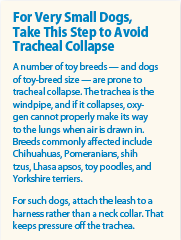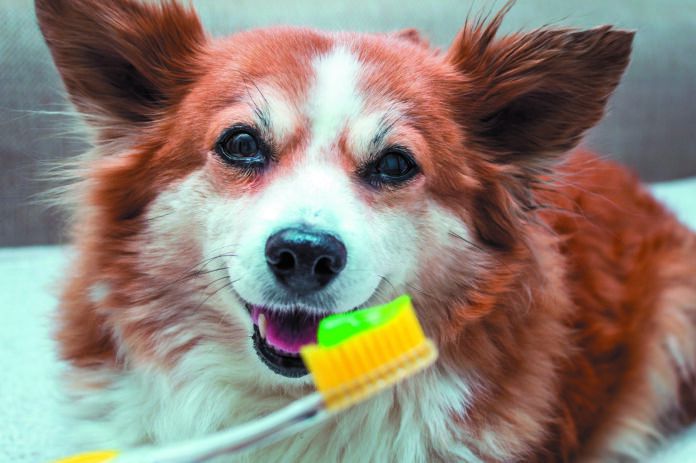Nearly one out of every two dogs in the U.S. weighs less than 25 pounds, making small and toy dogs the biggest single category of canine pets. Waning are the days when people needed good-size cattle dogs to herd sheep or hunting dogs to ferret out a grouse for dinner. Adorably little is in.
But small dogs come with their own set of health issues that require a different kind of care than large dogs. If you have a dog that weighs 25 pounds or less, here are four things you should do to improve your pet’s health and longevity.
1. Provide more conscientious dental care. When researchers reporting in The Veterinary Journal looked over 3 million medical records across 60 dog breeds, they found that dogs weighing less than 14.3 pounds were up to five times more likely to be diagnosed with periodontal disease than dogs weighing more than 55 pounds. And those weighing no more than 33 pounds (which includes everything from Chihuahuas and Yorkshire terriers to dachshunds, beagles, and pugs) were the most likely to be diagnosed with periodontal disease overall. Furthermore, a number of other studies have consistently shown that small dogs also develop periodontal disease at a younger age than larger ones. The reason is partly genetic and partly the fact that small dogs’ teeth aren’t quite small enough for their bodies, causing crowding in their mouths that leaves their oral cavities compromised.
If periodontal disease were just about tooth loss and other dental problems, that would be bad enough. But teeth compromised by periodontal, or gum, disease have an overload of harmful bacteria. If left untreated, the condition can cause the toxins to make their way into a dog’s bloodstream and pave the way for heart disease, kidney disease, and other very serious illnesses.
That’s why small dogs in particular should have their teeth brushed every day and also go for regular dental cleanings under anesthesia earlier in life than larger ones. The American Animal Hospital Association recommends that larger dogs go for annual cleanings starting at age 2 but small dogs, at age 1. Your small dog’s veterinarian might also recommend that your pet undergo dental cleanings two or three times a year rather than just annually, depending on the state of his oral health.
2. Look for a bum knee. We tend to think of large dogs jumping to catch Frisbees as the only ones who suffer orthopedic injuries, but little dogs are particularly prone to a musculoskeletal problem that can prove both debilitating and painful. It’s called patellar luxation, which means the kneecap moves out of its normal position. A dog of any breed can get a luxated patella, but it is most apt to occur in small ones such as a Chihuahua, Yorkshire terrier, or Pomeranian.
The problem occurs in the hind legs and usually stems from congenital joint or limb abnormalities rather than an injury. How can you tell if your dog has a patellar luxation? If you see your little pal “skipping” with his back legs here and there or “locking up” a limb at an odd angle, take him to the doctor. The veterinarian will check to see that it’s a luxating patella and not something else and will also grade the problem for severity. Sometimes the kneecap pops back into position by itself and can be treated with analgesics, exercise restriction, and perhaps physical therapy. In more severe cases that are graded higher, a surgical fix may be necessary. The pain can be quite bad, with significant cartilage damage, but surgery pretty much brings a dog back to himself.
3. Be on the lookout for signs of heart disease. While the most common type of heart disease in people is coronary artery disease (known idiomatically as clogged arteries), in dogs it’s mitral valve disease. And it’s little dogs who get it the most. According to an article in the Journal of Veterinary Cardiology, dogs weighing less than 20 pounds make up the vast majority of canine pets with the condition.
It’s not clear why small dogs are most prone to the condition, which causes blood to flow backwards in the heart when it’s supposed to go forward. Theories range from small dogs sharing a common ancestor with the genes for mitral valve disease to something about their anatomy that might increase their risk. Whatever the reason, small dogs should always be checked with a stethoscope during veterinary visits so the doctor can listen for a murmur — one of the first signs of the condition. Later signs may include shortness of breath, a chronic cough, intermittent gagging as if the dog is trying to clear his throat, and intolerance for physical activity.
There are a number of therapies that can help slow the progression of the illness. If left untreated, mitral valve disease will progress to heart failure much more quickly, causing a dog to lose stamina and have difficulty breathing earlier in life.
4. Talk to your veterinarian about vaccine doses. On paper, at least, the dose of a vaccine that is right for a Great Dane is right for a Chihuahua. The idea is that the amount of vaccine in the injection is the minimum amount that will keep a dog inoculated against a disease. But in real life, dogs weighing less than 25 pounds are more likely to have an adverse reaction to a vaccine — discomfort or swelling at the vaccination site, mild fever, temporary loss of appetite, or lack of energy.
To be sure, the risk of an adverse reaction to a vaccine is quite small for any dog — on the order of 45 reactions per 10,000 dogs for those weighing 20 pounds or less versus 12 per 10,000 for dogs weighing at least 100 pounds. Because of that difference, however, the American Animal Hospital Association says that some people, in consultation with their veterinarians, may want to wait two weeks after their small dog has his core vaccines before giving him the non-core vaccines. And at least one veterinary textbook advises that the increased prevalence of adverse reactions in small-breed dogs “suggests that veterinarians should look carefully at the practice of giving the same vaccine dose to all dogs irrespective of their size.”
order of 45 reactions per 10,000 dogs for those weighing 20 pounds or less versus 12 per 10,000 for dogs weighing at least 100 pounds. Because of that difference, however, the American Animal Hospital Association says that some people, in consultation with their veterinarians, may want to wait two weeks after their small dog has his core vaccines before giving him the non-core vaccines. And at least one veterinary textbook advises that the increased prevalence of adverse reactions in small-breed dogs “suggests that veterinarians should look carefully at the practice of giving the same vaccine dose to all dogs irrespective of their size.”
It’s something to work out on a dog-by-dog basis. Tufts veterinary internist Michael Stone, DVM, says he always administers a full dose of the rabies vaccine no matter what the dog’s size because of “its human health importance.” With other vaccines, he says, “I might decrease the dose, but not routinely.”





